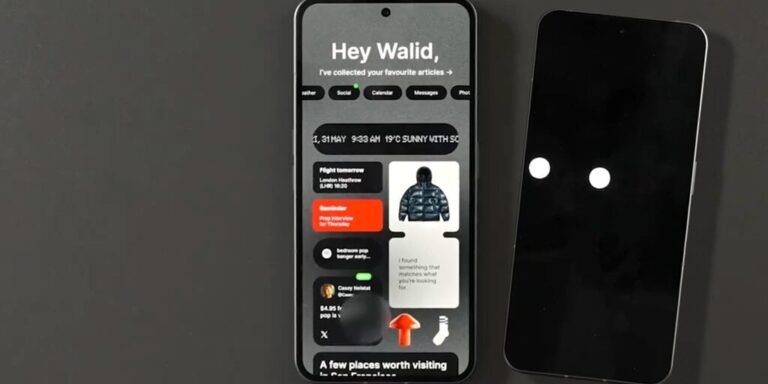[ad_1]
London-based electronics company Nothing wants to revolutionize smartphones by doing away with traditional apps in favor of an interface that’s entirely managed by AI.
“The way we use smartphones needs to be redefined,” Nothing CEO Carl Pei declared on Twitter. “The current user experience hasn’t evolved in over a decade… The next era requires highly personalized, dynamic, cross-device interfaces.”
Pei is betting on AI as the best way to get there, saying it will enable smartphone user interfaces that are completely different from the ones we know today. He shared a preview of what the next-generation Nothing phone will look like, with a big departure from the typical grid of apps and widgets.
“We’ve been exploring how to deeply integrate AI into the operating system,” said Walid, the Nothing designer featured in the video shared by Pei. “We tried to reimagine the home screen – to be more than just a launcher, but a hub of contextual, relevant information.”
In “tomorrow’s post-app world,” Nothing proposes, users will simply interact with AI and ask it to do anything. The AI assistant will then coordinate the necessary applications in the background and complete the request without requiring further interaction from the user.
The idea behind Nothing, he said, is to give every user “a highly personalized companion that feels like a best friend.”
Walid demonstrated setting up the AI assistant and asked what personality traits the system looked for in a companion: After he answered that he liked people who were fun, thoughtful and had a good sense of humor, the assistant introduced itself as Oliver.
“We’ve been trying out prototypes of this internally for the last week or so,” he reported. “Each of us got a different companion customized to fit us perfectly.”
Pei argued that his company is ready to compete in the increasingly competitive AI field.
“Over the last three and a half years, we’ve worked hard to build out our end-to-end capabilities, and now that we’ve reached stability and have a solid growth plan, we’re ready to shift gears,” he said. “Think of this as our entry into the consumer AI race.”
Nothing’s companion, at least in the preview, looks a lot like ChatGPT’s voice chatbot: a flat circle on a black background with a pleasant, human-like voice. Nothing hasn’t said whether the assistant runs locally or in the cloud, though, which is likely to be a cloud-dependent feature given the computing power required to run similar AI tools.
Image: Carl Pei/Twitter
Pei founded Nothing in 2021 after leaving Chinese electronics maker OnePlus, which entered the smartphone market with the $300 OnePlus One in 2014. Nothing’s first phone will be available in 2022, priced under $500 and running a customized version of Google’s Android operating system.
The Nothing Phone (2) has been steadily moving towards the high end of the smartphone market, garnering rave reviews as a $600 flagship device aimed at Apple, Google and Samsung. Last month, a more modest configuration, the Nothing Phone (2a), was released for $350.
It’s unclear whether the redesigned interface Pei showed off today will be part of the yet-to-be-announced Nothing Phone (3), but he did say it will be released in 2025.
Image: Carl Pei/Twitter
Pei didn’t reveal any further details about the new device, so its design, specs and features remain a mystery. Hardware enthusiast sites and forums speculate that it could feature an upgraded Snapdragon 8 processor, upgraded camera module and a larger battery. But Pei’s key selling point is the revamped user interface.
“We’ve come a long way as the only company that has built a smartphone business in the last decade,” he said. “We’ve also fostered a creative culture within the company that values great UX and thoughtful integration of software and hardware.”
Meanwhile, other smartphone companies are already incorporating AI capabilities into their devices: the Google Pixel series with the new Google Tensor chip has on-device large language models (LLMs), while the Samsung Galaxy S24 Ultra with Galaxy AI offers features like live translation and Circle to Search.
Smartphones equipped with the new Qualcomm Snapdragon 8 Gen 3 processors, such as the Xiaomi 14 and new Motorola models, will also offer AI-powered features.
Ultimately, the best way to carry AI around with you is likely not in a dedicated device, but in the ubiquitous smartphone. The Humane AI pin was criticized for being impractical, having high latency, and being inaccurate. The more well-received Rabbit R1 turned out to be powered mostly by apps running scripts in the cloud. And the promised Limitless AI pendant has yet to prove its worth.
Editor: Ryan Ozawa.
[ad_2]
Source link


